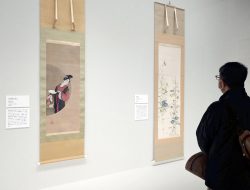
Accessories using resin-coated candies are sold at Nanaco Plus+’ main store in Kyoto. The candies have a beautifully clear surface due to the transparent coating.
11:38 JST, March 11, 2022
Colorful striped candy balls known as temari-ame and slices of candy with the same image on them, such as a windmill or a beckoning cat, called kintaro-ame — these traditional Japanese candies are real but they can’t be eaten. Instead, they are coated with transparent resin and sold as accessories.
These trinkets can give you a unique look and a bit of excitement, too.
Hair elastics and netsuke accessories decorated with swinging temari-ame, a small charm with a kintaro-ame slice bearing a round apple motif, earrings with similar decorations and kanzashi hairpins are among the many colorful items sold at a store in the Shijo Kawaramachi area in Kyoto. They are made by Nanaco Plus+, a company specializing in candies and candy accessories.
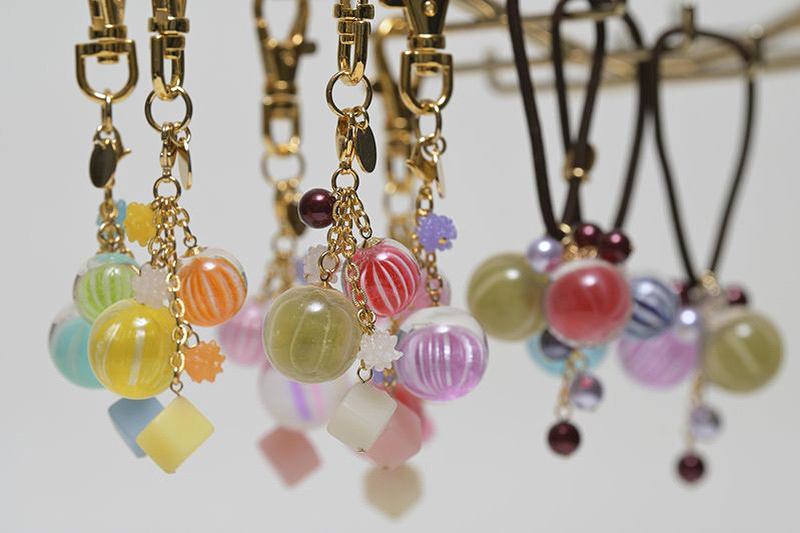
Temari-ame candy accessories that swing back and forth
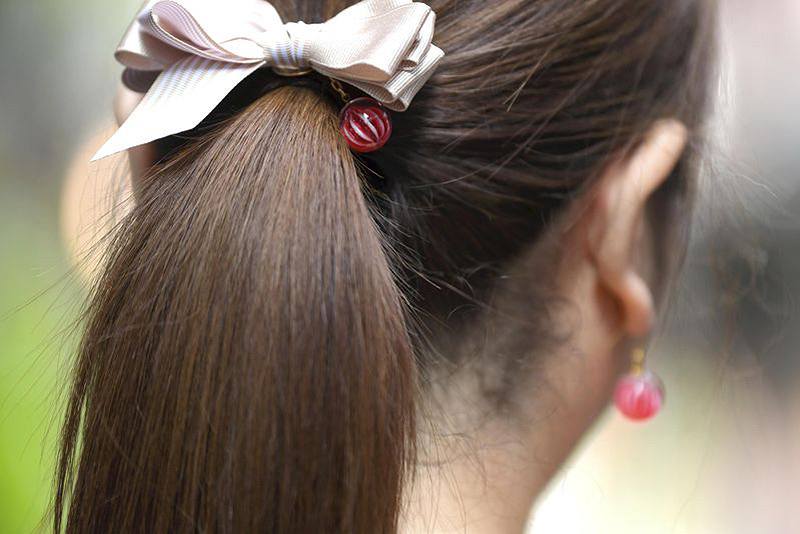
An earring and ribbon clip, both decorated with a temari-ame candy
“We seal and preserve the delicate and gorgeous atmosphere of traditional candies made by skilled craftspeople,” said Yuki Mitani, president of the company, with a smile. Mitani calls herself a “candy auntie.”
Coating candies with transparent resin makes it possible to use them as accessories. Their fine patterns are magnified a little through the coating, and the smooth surface is enhanced by transparent parts in the candies themselves, making them shimmer.
The most popular item is a small temari-ame candy with thin white or yellow lines on a light blue or pink background, Mitani said.
The idea of candy accessories was conceived in 2004 when the company started making accessories using imitations of traditional dried confectioneries such as rakugan and kohakuto. Although the company tried to make imitations of candies such as temari-ame and kintaro-ame, it was unable to make them look realistic. Then they came up with the idea of using real candy.
Now, the company offers accessories using real candies made with traditional methods in cooperation with 12 candy shops around the country, including in Kyoto, Osaka, Aichi and Nagano prefectures.
Mitani said, “I feel the older generation likes the nostalgic feeling, and the younger generation finds something new in them.” Some men buy the accessories as gifts for women, she said.
As the candies are real, each individual product has a different look and feel even when they are of the same type. They are very enjoyable, but they do need to be handled and stored more carefully than ordinary accessories, such as not being left in the burning sun or in hot areas for a long time, Mitani said.
Like many other traditional businesses, handmade candy production faces the problem of a lack of successors. In fact, many such companies are closing down.
Against this backdrop, Mitani hopes the accessories will raise the profile of traditional Japanese candies, which are known for their craftsmanship.
“I hope that our candy accessories will lead people to learn about and eat traditional Japanese candy,” she said.
New way to eat candy
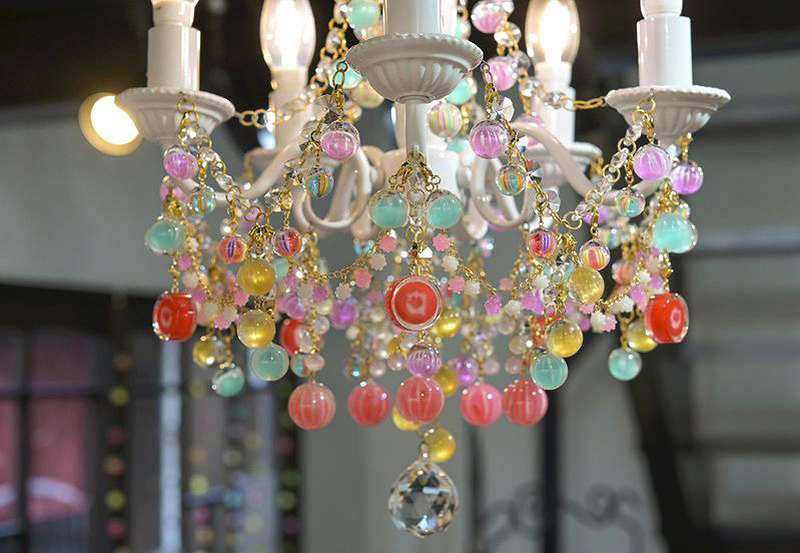
A chandelier in the store decorated with candy ornaments
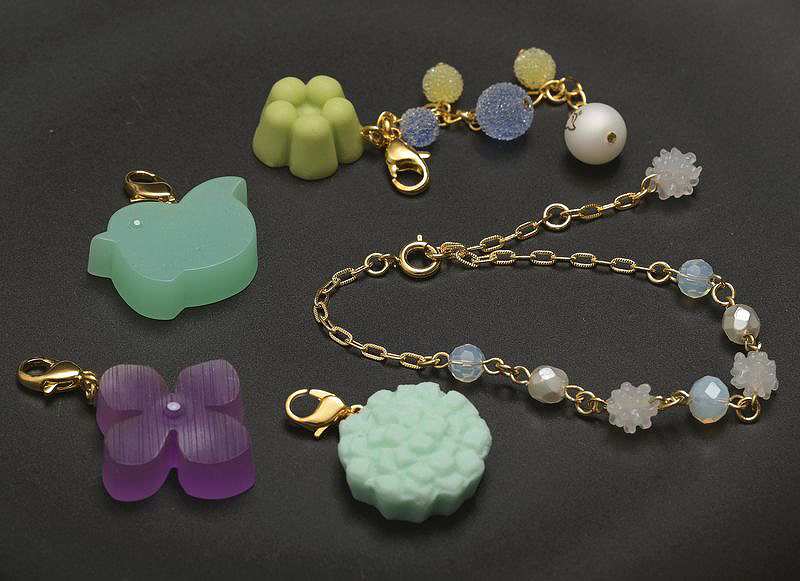
Accessories with imitations of kompeito, rakugan and kohakuto candies are also available.
Mitani was born in Osaka Prefecture in 1966. After obtaining design expertise at a sportswear planning company, she started her own business. She founded Nanaco Plus+ in 2004 and has promoted the appeal of Japanese candy ever since.
The company also sells edible candy. In addition to temari-ame and kompeito, a small round candy with knobbles, the company offers a wide variety of modern designs such as kintaro-ame with cat, dog and panda motifs, and tricolored temari-ame.
Last year, the company launched a new candy in the form of sprinkles in collaboration with a long-established candy store in Nagano Prefecture. It was an effort to propose a new way to eat candy.
The product is made by taking thin sheets of dried mizu-ame starch syrup and crushing them into small pieces by hand. The product comes in pink, yellow and blue, and can be sprinkled on a cafe latte instead of sugar. It can give a new texture to donuts and fruit, too.
“It also goes perfectly with foods that use cream,” Mitani said.
The company has its main store in Kyoto and a branch store in the Tokyo Solamachi shopping complex in Sumida Ward, Tokyo.
Visit https://nanaco-plus.com/ for more information.
"Culture" POPULAR ARTICLE
-

Van Cleef & Arpels Dazzles with Art Deco Artisanry at Tokyo Exhibit
-

Disney’s ‘Twisted-Wonderland’ Animated Series Puts Villains in Spotlight: New Show Features School Inspired by Classic Disney Films
-

Ayumi Hamasaki’s Shanghai Concert Canceled Day Before Schedule as Part of Beijing Backlash
-

‘The World Masterpiece Theater Series’ Celebrates 50 Years; Animator Looks Back on Creating Anime Classics
-

Popularity of Piggy Banks Across Time and Place Seen at Bank’s Museum of Money Boxes in Hyogo Pref.
JN ACCESS RANKING
-

Tokyo Economic Security Forum to Hold Inaugural Meeting Amid Tense Global Environment
-

Keidanren Chairman Yoshinobu Tsutsui Visits Kashiwazaki-Kariwa Nuclear Power Plant; Inspects New Emergency Safety System
-

Imports of Rare Earths from China Facing Delays, May Be Caused by Deterioration of Japan-China Relations
-

University of Tokyo Professor Discusses Japanese Economic Security in Interview Ahead of Forum
-

Japan Pulls out of Vietnam Nuclear Project, Complicating Hanoi’s Power Plans




